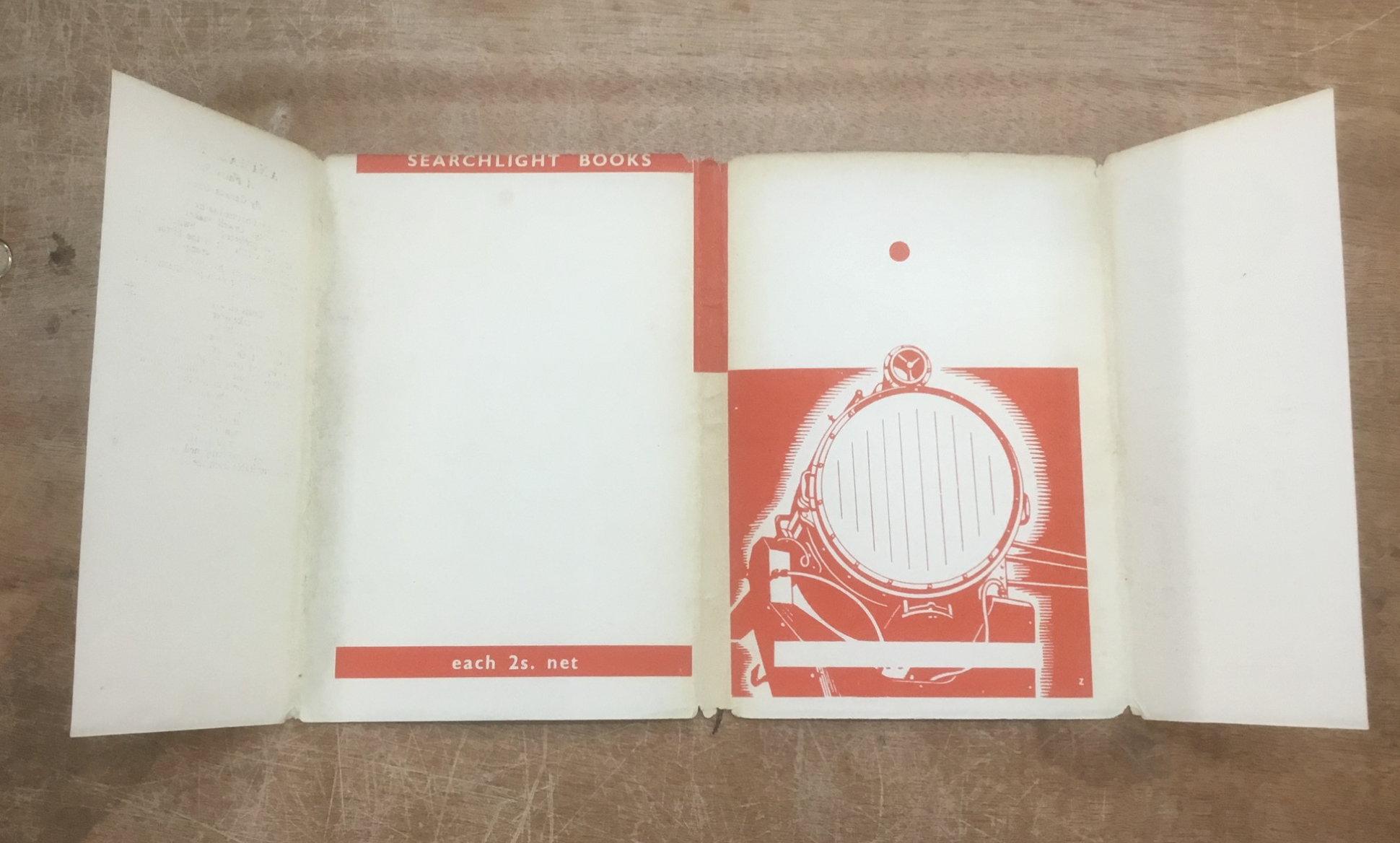Secker and Warburg Ltd. (London, UK)
Series dates: 1941-1942
Size: 4.25″ x 7″
Updated 5/26/2023
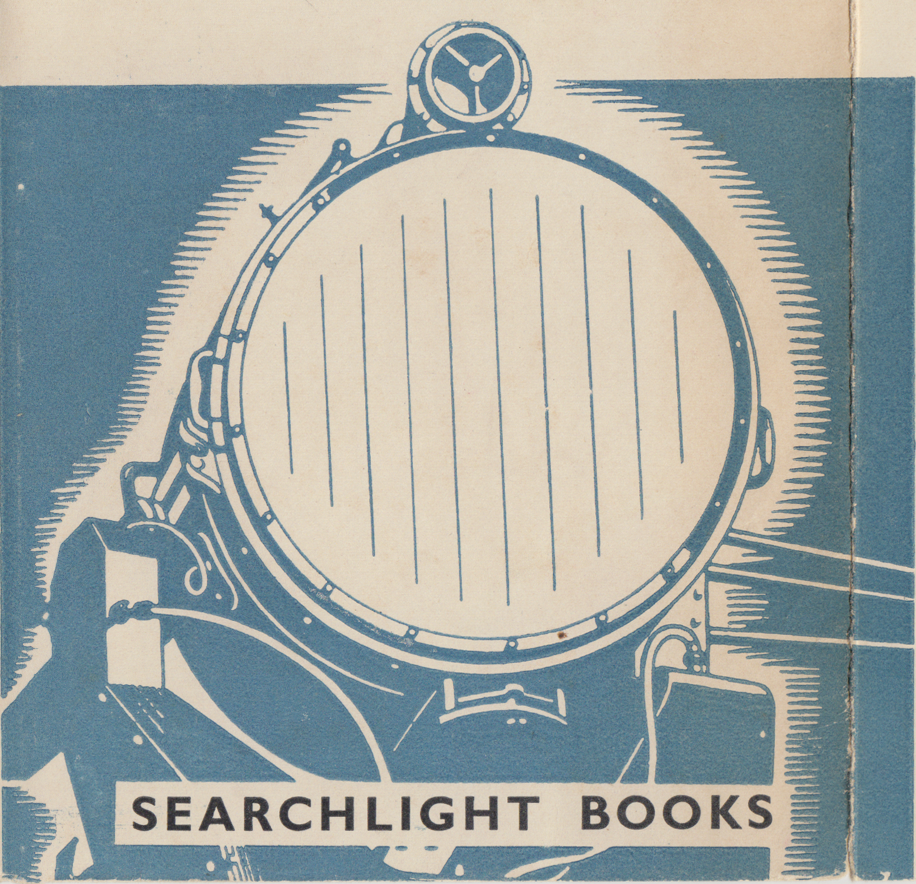
The Searchlight Books consisted of concise, extended essays all written for the series. The series was edited by T. R. Fyvel and George Orwell. Eighteen newly written titles, issued in hardcover and paperback, were planned. Among the authors in the series:
“From the world of letters, Stephen Spender, Cyril Connolly, T. Worsley, Joyce Cary and Olaf Stapledon agreed to participate. Journalism was represented by Ritchie Calder, William Connor (Cassandra) and Bernard Causton. The swollen refugee community provided the series with three potential recruits in Arthur Koestler, Stephan Haffner and Arturo Barea. Francois Lafitte and George Catlin, husband of the pacifist Vera Brittain, were academics. One tentative contributor, Michael Foot, defies categorization. Still in his twenties, he had already made a mark as author, journalist, editor and as a protege of Aneurin Bevan, on the left wing of the Labour Party.” (David Costello, “Searchlight Books and the Quest for a ‘People’s War, 1941-42,” 1989, p. 260-261).
The association with Orwell seems to have made the series somewhat collectible. See also Searchlight Books by Darcy Moore.
Poet Stephen Spender’s Life and the Poet (shown below) was the last title published in the series in 1941, as #18. Jackets are common to the series with one exception (#17), using a distinctive spotlight graphic designed by political cartoonist Philip Zec. The books were issued in both cloth and paperback. Spender’s title was, I believe, only issued in paperback.
The spine includes the title and author, a price (2s. net), and “S.B. #18.” The series name is indicated on the front of the jacket. The front jacket flap blubs the author, includes the jacket designer, and price.
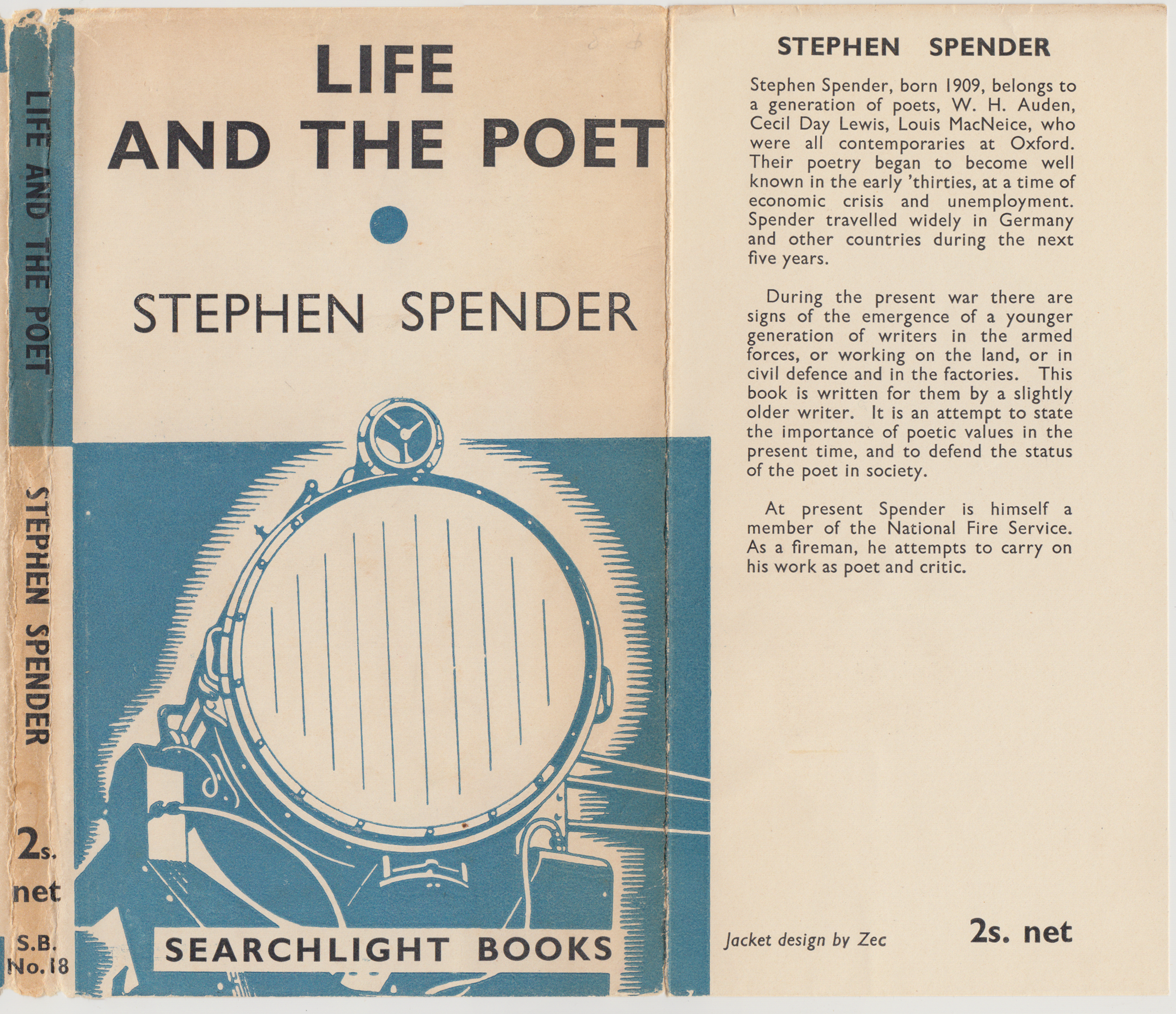
Eleven of the eighteen titles planned were published. As far as I can find, #9 was never assigned a title. Of the rest, #6, #7, #8, #12, #13, and #15 were assigned titles (see below) but not published. According to Costello (1989), Foot (#7) and Lafitte (#14) could not complete their contributions due to other commitments. Koestler (#13) was called up for military service. The series was also affected by a bomb that hit the Warburg offices in April of 1941 (causing the loss of printing paper and stock). This may have accounted for the shift to paperback titles (which used less paper) for some titles around the time of the bombing.
The rear of the Spender jacket includes a list of eleven of the eighteen planned titles (the entirety of titles published in the series), along with the series name and price. The rear jacket flap includes additional Spender books.

Below find a list of titles – as planned and as published – in the Searchlight Books series. Those not published are noted with an asterisk (*). I’ve included brief reviews from the Spender jacket above. I’ve also indicated if I’ve seen cloth (C) or paperback (P), or both, for each title. There does not seem to be much logic as to which books were printed in which format, although the paperback titles may be – as noted above – the consequence of the bombing of the publisher’s office (and loss of paper) in April 1941.
1. The Lion And The Unicorn by George Orwell (1941) (C)
Socialism and the English genius. “An exciting and important little book.” -The Listener.
2. Offensive Against Germany by Sebastian Haffner (1941) (C)
How to weaken Germany in a propaganda war. “A deadly serious book, demanding most earnest consideration.” -Times.
3. The Lesson Of London by Ritchie Calder (1941) (C)
The London Blitz and what it should have taught us. “Sound reporting, solid analysis. It is a duty for every citizen to read it.” H.J. Laski, in Daily Herald.
4. The English At War by Cassandra (1941) (C, P)
Certainly voices the sentiments of the common people more vigorously than any other book of its time. Over 30,000 sold.
5. The End Of The Old School Tie by T. C. Worsley; forward by George Orwell (1941) (P) [colophon indicates first printing of this title was destroyed by the April 1941 bombing]
What to do about the public schools and a new democratic educational system. “His analysis of the situation and its consequential evils is admirable.” -C. E. M. Joad, in New Statesman.
*6. New Map for Europe by “Viator”
*7. Above All Things – Liberty by Michael Foot
*8. The Artist and the New World by Cyril Connolly
*9. ?
10. Struggle For The Spanish Soul By Arturo Barea (1941)
The unbiassed truth about Spain, General Franco, and Spanish Fascism. “I don’t think I ever read 120 pages that contained more enlightenment.” -Reynold’s News.
11. The Case For African Freedom by Joyce Cary; forward by George Orwell (1941) (H, P)
How to combat the growing menace of African disease, poverty and ignorance. “All those interested ought to read this disturbing yet robust book.” -The Listener.
*12. Can Britain and America Unite by G.E. Catlin
*13. The Streets of Europe by Arthur Koestler
*14. Health for Citizens by Francois Lafitte
15. The Moral Blitz by Bernard Causton (1941)
A study of Christianity and war propaganda. The Bishop of Chichester writes: “A very good book, standing for something very definite in the way of Christianity.”
16. Beyond The ‘Isms by Olaf Stapledon (1942) (P)
The author of Last and First Men stresses the need of spiritual values in the modern world of swift material progress.
**17. Parents Revolt by Richard Titmuss (1942) (C)
To check the declining birthrate with all its disastrous effects, we must improve social conditions and enlarge parental freedom.
18. Life And The Poet by Stephen Spender (1942) (P)
A study of poetry and its subject matter, and an estimate of the effects of politics and propaganda on poets.
Dover Front by Reginald Foster, was published by Secker & Warburg in 1941 as a “A Searchlight Reporter Book.” (C)
Bless ‘Em All by “Boomerang” (Alan Wood) was, according to Warburg, “published outside the series” in March 1942. This may have been the title planned for #9 in the series.
A Gang of Ten by Erika Mann & Richard Erdoes, 1944, is a children’s book listed as part of the series in several entries on WorldCat.
*Not published
**Published, but apparently not as part of the series, with a non-series dust jacket. Included on the jacket of the Spender title as part of the series, but not in the series list in the book itself (see below).
Emphasizing the paper shortage faced by Secker and Warburg during WW2 are copies of the first edition of Orwell’s Animal Farm (1945) which use left-over dust jacket blanks from the Searchlight Books series. Many common jackets for series books were printed with common elements, then overprinted with title specific details (often in a contrasting color) as needed. In this case, unused jacket blanks (three years after the last Searchlight Books series title was published) were reused for most of the 4500 copies of the first edition of Animal Farm (source). This jacket (and book) not in my collection.
The paper covers of Spender’s Life and the Poet is sparse in design. The spine remains similar to the jacket spine. The cover includes only the title and author and a scaled-down “spotlight” graphic.
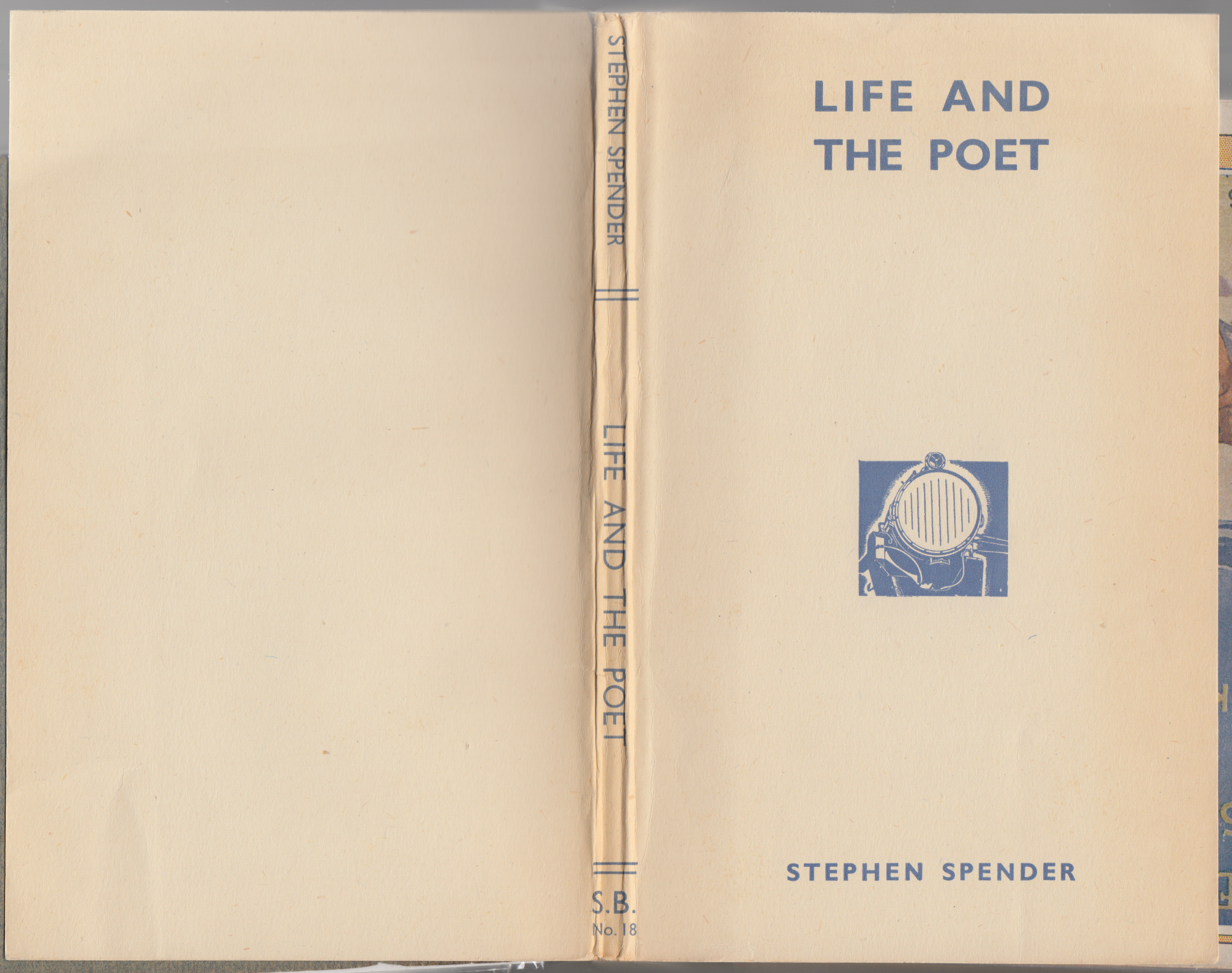
The half title page with the series name and number:
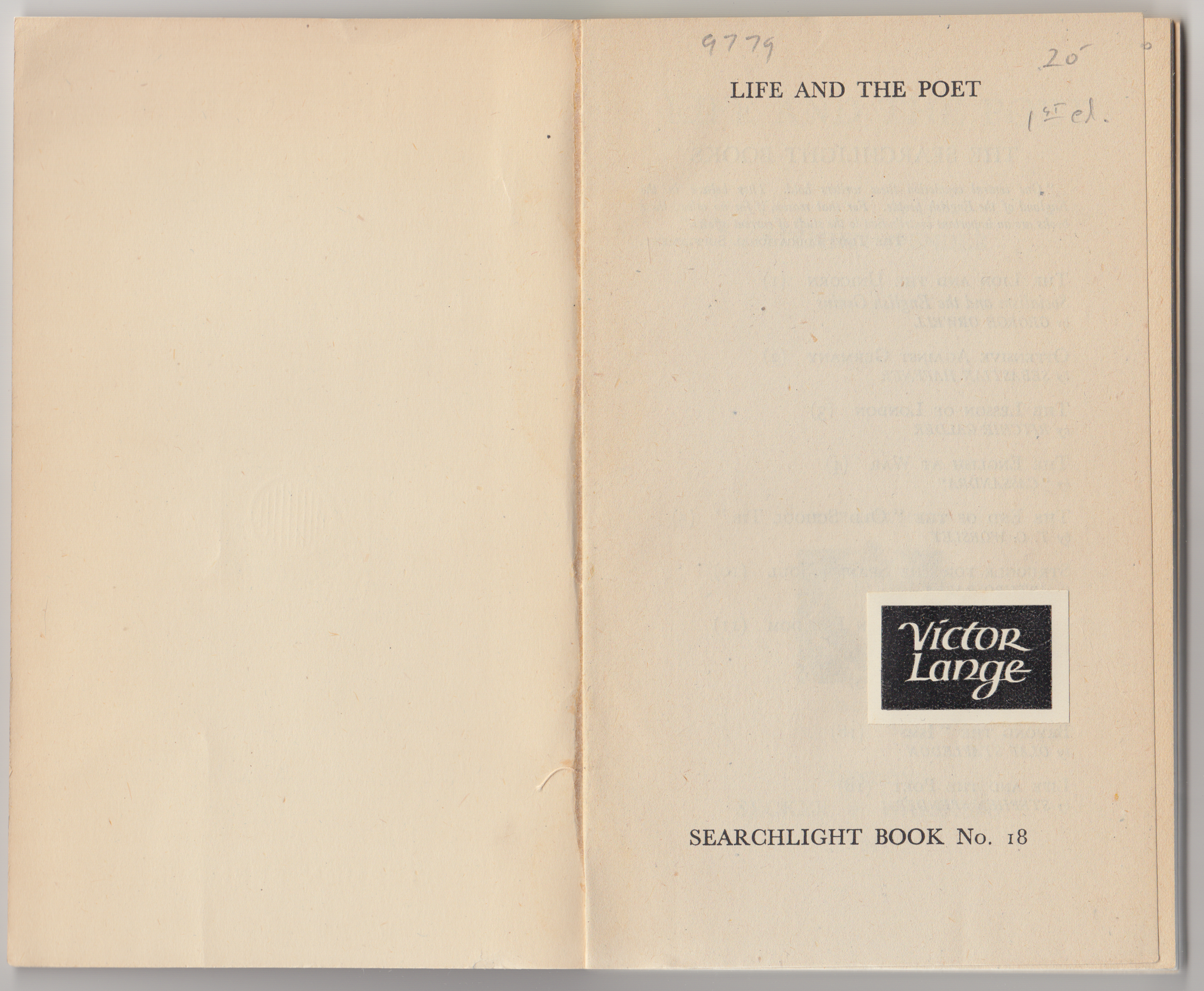
The series titles are listed, missing #17, facing the title page. The title page includes the title, author, series name, and spotlight graphic, along with the place of publication, publisher, and date.

The copyright page includes the month and year of printing, March 1942. “Made and Printed in Great Britain by Morrison and Gibb LTD., London and Edinburgh”
Additional titles by Spender face the copyright page.

The table of contents and beginning of chapter 1:

The last page includes a cryptic “W 3018.”

